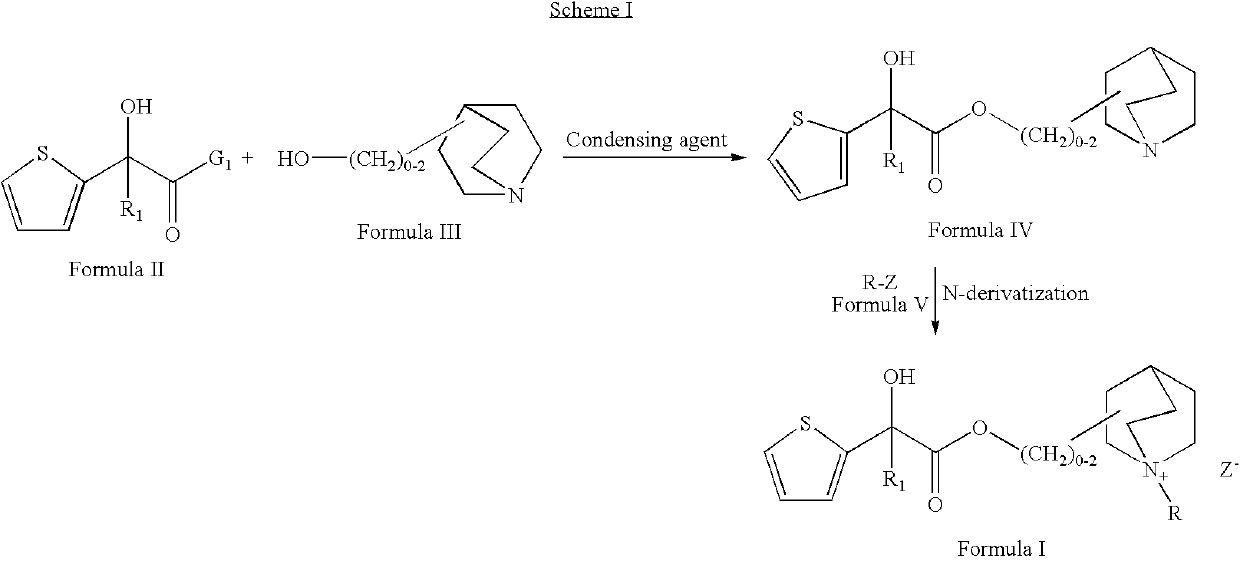Muscarinic receptor antagonists
a technology of muscarinic receptor and antagonist, which is applied in the field of muscarinic receptor antagonists, can solve the problems of limited therapeutic utility and poor tolerability of muscarinic agents
- Summary
- Abstract
- Description
- Claims
- Application Information
AI Technical Summary
Benefits of technology
Problems solved by technology
Method used
Image
Examples
example 1
Synthesis of (3R)-3-{[(3,3-difluorocyclopentyl)(hydroxy)thiophen-2-ylacetyl]oxy}-1-methyl-1-azoniabicyclo[2.2.2]octane (Compound No. 14)
Step a: Synthesis of 1R,2R+1S,2S or (1R,2S+1S,2R)-ethyl (3,3-difluorocyclopentyl) (hydroxy)thiophen-2-ylacetate
[0098]To a solution of 1R,2R+1S,2S or (1R,2S+1S,2R)-(3,3-difluorocyclopentyl)(hydroxyl)thiophen-2-ylacetic acid (0.0007 mol, 200 mg) in dimethylformamide (about 2 ml) was added sodium bicarbonate (0.0009 mol, 83 mg) followed by ethyl iodide (0.0014 mol, 0.08 ml). The reaction mixture was stirred at 25° C. for about 12 hours. The reaction mixture was quenched with water and extracted with ethyl acetate. The combined organic layer was washed with water, brine and dried over anhydrous sodium sulphate and concentrated under reduced pressure. The residue thus obtained was purified by preparative chromatography to obtain the title compound. Yield: 202 mg.
[0099]1H NMR (CDCl3) δ: 7.22-7.23 (m, 1H), 7.10-7.11 (m, 1H), 6.96-6.98 (m, 1H), 4.24-4.35 (q...
example 2
Preparation of (3R)-3-{[hydroxy(dithiophen-2-yl)acetyl]oxy}-1-methyl-1-azoniabicyclo[2.2.2]octane bromide (Compound No. 1)
Step a: Synthesis of (3R)-1-azabicyclo[2.2.2]oct-3-yl hydroxy(dithiophen-2-yl)acetate
[0111]To the suspension of (R)-1-azabicyclo[2.2.2]octan-3-ol (0.00049 mmol, 63 mg) in dry toluene (about 5 ml) was added freshly prepared sodium ethoxide (0.0006 mol, 43 mg) followed by ethyl hydroxyl (dithiophen-2-yl)acetate (0.0006 mol, 200 mg) under argon atmosphere. The mixture was slowly heated for about 2.5 hours (1 hour at 70 to 80° C. and 1.5 hours at 80 to 95° C.) and the azeotrope formed by the liberated ethanol and the toluene was distilled (˜1.5 ml). When the internal temperature reached to 110 to 115° C., ˜2 ml of distillate was collected. Added about 4 ml of anhydrous toluene and slow distillation was continued. Heating was stopped after ˜3 ml of distillate was collected. The reaction was cooled on an ice bath and 2 ml of diethyl ether was added followed by addition...
PUM
| Property | Measurement | Unit |
|---|---|---|
| temperature | aaaaa | aaaaa |
| chiral purity | aaaaa | aaaaa |
| temperature | aaaaa | aaaaa |
Abstract
Description
Claims
Application Information
 Login to View More
Login to View More - R&D
- Intellectual Property
- Life Sciences
- Materials
- Tech Scout
- Unparalleled Data Quality
- Higher Quality Content
- 60% Fewer Hallucinations
Browse by: Latest US Patents, China's latest patents, Technical Efficacy Thesaurus, Application Domain, Technology Topic, Popular Technical Reports.
© 2025 PatSnap. All rights reserved.Legal|Privacy policy|Modern Slavery Act Transparency Statement|Sitemap|About US| Contact US: help@patsnap.com



